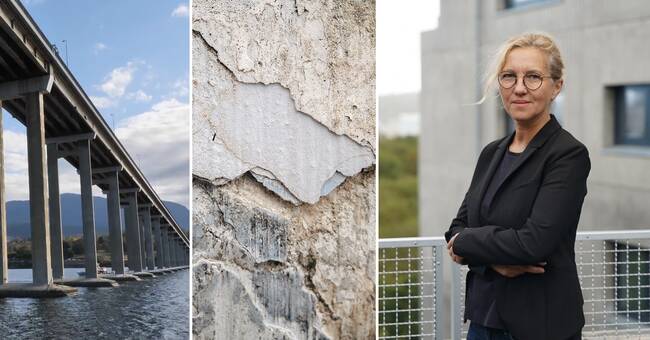Concrete is a natural carbon sink.
Unfortunately, the process takes hundreds of years before it becomes noticeable.
Now researchers around the world are working to make better use of the climate's climate benefits than we do today.
- All our bridges and facades absorb carbon dioxide without us doing anything at all.
What if we were to design our houses to absorb more carbon dioxide?
Such optimization would drastically reduce the concrete industry's emissions, says Katarina Malaga, researcher in chemical and mechanical degradation of building materials (stone and concrete) and professor in sustainable construction.
New cement of old concrete
To find a more climate-smart concrete, researchers at the Department of Architecture at one of Tokyo's universities have tried to extract cement from old concrete.
By pulverizing the material, immersing it in a hot water bath and allowing a high pressure of carbon dioxide to flow through the system, they have produced porous small cylinders of carbonated concrete, ie limestone.
- It is a natural chemical reaction that takes place called carbonation.
When the cement paste reacts with carbon dioxide, it is converted to its original form, which is limestone.
The limestone is crystallized in the pipes in which it circulates. The heat from the water increases the speed of the process, says Katarina Malaga.
The method will save natural resources by recycling cement.
The carbon dioxide used in the experiment is collected from industries that would otherwise be released into the air.
Ordinary concrete contains five percent air.
The specimens that the Japanese researchers have obtained so far contain almost 50 percent air, which is not suitable as a building material.
In Sweden, on the other hand, research on sustainable concrete has come a long way.
This is how Sweden's emissions can be halved
Researchers in concrete at the state research institute RISE have already established that carbon dioxide emissions from the concrete industry can be more than halved with the help of new working methods.
- In Sweden, we produce approximately two million tonnes of waste every year.
We tear and blow up new without looking at what we can do with the existing waste, says Katarina Malaga.
According to her, the solution is carbonation, reuse and replacement materials in cement.
- If we roughly crush old concrete at our waste stations, surfaces are created that can absorb carbon dioxide directly from the air, ie carbonate.
Then you can use the carbonated material as ballast (filling) in new constructions.
Carbonated concrete crusher has very good mechanical properties that are good to build with.
Cement is a vital ingredient in concrete that makes it solidify.
At the same time, new cement production accounts for 95 percent of the concrete industry's carbon dioxide emissions.
By mixing the cement with more environmentally friendly materials, the emissions can be reduced.
The future requires new working models
In Germany and Austria, there are already research facilities that crush old concrete to accelerate carbonation.
In the Netherlands, there is legislation that forces players in the concrete industry to reuse old material.
These are conditions we lack in Sweden.
- We lack a complete process with routines for quality assurance that make it easy for players to use waste.
Today, new material is cheaper than old, but in the long run, reuse will be most effective.
Both financially and to save natural resources, says Katarina Malaga.
On Sunday 24/10 on SVT2 at 20:00, you can watch SVT's climate hearing - "What does science say about climate change and how does politics relate to scientific facts? Politicians and researchers in the studio. "

